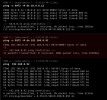I have an interesting one that I am hoping someone can point me in the right direction on.
I have a cluster of three pve hosts on vlan1, and some guests on both vlan1 and vlan2. MTU is set to 9000 across the board. Guest VM's on vlan1 can communicate "correctly" with the host PVE machines, ping correctly using a manual packet size (ping -s 8972 -M do 192.168.0.92). However, guests on vlan2 cannot communicate with the pve hosts on vlan1, nor any guests, nor external hosts on vlan1.
So I have whittled this down to a inter-vlan problem. I switched from standard linux bridges to OVS, just to see if that helped, It did not.
Running a unifi setup with Jumbo Frames enabled across all switches in the background.
Here's my /etc/network/interfaces from one PVE host (ignore the 10.10.* interface, those are for a separate 100g corosync network between pve hosts):
Example results from a guest VM on vlan2 (10.0.0.15). First to another vlan2 guest, then to the pve host that it's on, once with jumbo frames, once without:

Guest VM's are running virtio network interfaces, tagged with appropriate vlan tags.

No SDN usage here.
Any guidance on where to look next would be appreciated!
I have a cluster of three pve hosts on vlan1, and some guests on both vlan1 and vlan2. MTU is set to 9000 across the board. Guest VM's on vlan1 can communicate "correctly" with the host PVE machines, ping correctly using a manual packet size (ping -s 8972 -M do 192.168.0.92). However, guests on vlan2 cannot communicate with the pve hosts on vlan1, nor any guests, nor external hosts on vlan1.
So I have whittled this down to a inter-vlan problem. I switched from standard linux bridges to OVS, just to see if that helped, It did not.
Running a unifi setup with Jumbo Frames enabled across all switches in the background.
Here's my /etc/network/interfaces from one PVE host (ignore the 10.10.* interface, those are for a separate 100g corosync network between pve hosts):
Code:
auto lo
iface lo inet loopback
iface enp1s0 inet manual
auto enp65s0
iface enp65s0 inet static
address 10.10.0.1/24
mtu 9000
#Mellanox Eth0 corosync
iface enp65s0d1 inet manual
#Mellanox Eth1 corosync
auto enp66s0f0
iface enp66s0f0 inet manual
ovs_type OVSPort
ovs_bridge vmbr0
ovs_mtu 9000
ovs_options vlan_mode=native-untagged
#Intel X520 SFP+
iface enp66s0f1 inet manual
#Intel X520 SFP+
auto ovsport_host
iface ovsport_host inet static
address 192.168.0.92/24
gateway 192.168.0.1
ovs_type OVSIntPort
ovs_bridge vmbr0
ovs_mtu 9000
ovs_options tag=1
auto ovsport_vlan2
iface ovsport_vlan2 inet manual
ovs_type OVSIntPort
ovs_bridge vmbr0
ovs_mtu 9000
ovs_options tag=2
auto vmbr0
iface vmbr0 inet manual
ovs_type OVSBridge
ovs_ports enp66s0f0 ovsport_host ovsport_vlan2
ovs_mtu 9000
source /etc/network/interfaces.d/*Example results from a guest VM on vlan2 (10.0.0.15). First to another vlan2 guest, then to the pve host that it's on, once with jumbo frames, once without:

Guest VM's are running virtio network interfaces, tagged with appropriate vlan tags.
No SDN usage here.
Any guidance on where to look next would be appreciated!
Last edited:

